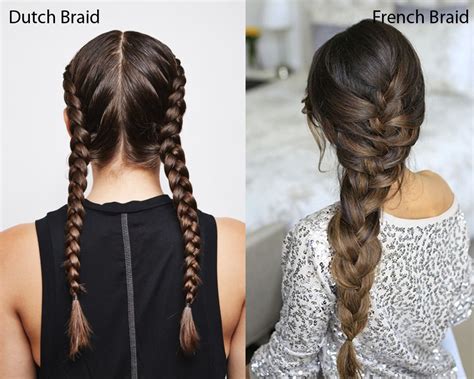Introduction: The Two Titans of Braiding
The realm of hairstyling boasts myriad braiding techniques, each with its unique charm and intricacies. Among these, Dutch braids and French braids stand tall as the most celebrated and versatile. Both techniques have graced countless heads, from royalty to commoners, captivating hearts with their intricate patterns and elegant allure.

Understanding the Distinctions: A Comparative Analysis
While Dutch and French braids share a common purpose of interlacing strands of hair, they diverge in their execution, resulting in distinct aesthetic effects.
1. The Layering Factor:
- Dutch Braids: Also known as inverse braids, execute an “under-crossing” method, where strands are placed underneath one another. This creates a raised, embossed effect that adds volume and depth to the braid.
- French Braids: Employ an “over-crossing” technique, where strands are passed over one another, resulting in a more delicate, flatter braid that sits closer to the scalp.
2. The Feeding Pattern:
- Dutch Braids: Feed in additional strands from the sides with each stitch, gradually building width and volume as you progress.
- French Braids: Also incorporate additional strands, but only from one side (typically the outside) per stitch. This results in a more narrow and refined braid.
3. The Final Look:
- Dutch Braids: Showcase pronounced texture, with visible volume and intricate patterns.
- French Braids: Offer a more seamless and refined appearance, with a flatter, less bulky profile.
The Beauty Spectrum: Versatility and Applications
Both Dutch and French braids hold their own in the versatility arena, catering to a wide range of hair types, lengths, and occasions.
1. Hair Type Compatibility:
- Dutch Braids: Ideal for thick or coarse hair, as they can handle the additional weight and texture.
- French Braids: Well-suited for fine or thin hair, as they help create the illusion of volume and fullness.
2. Braid Length Dynamics:
- Dutch Braids: Suitable for both short and long hair, though they shine on hair with sufficient length to showcase the raised effect.
- French Braids: Work well with medium to long hair, allowing for intricate patterns and elaborate styles.
3. Occasions and Aesthetics:
- Dutch Braids: Perfect for bold and edgy styles, such as buns, ponytails, and headbands.
- French Braids: Lend an air of elegance and sophistication, suitable for formal events, weddings, and other special occasions.
The Evolution of Braiding Techniques: From Traditional to Modern
The art of braiding has witnessed a remarkable journey over millennia, adapting to changing fashion trends and cultural influences.
1. Historical Origins:
- Dutch Braids: Traced back to the Netherlands in the 15th century, used as a protective style by young women.
- French Braids: Believed to have originated in the French countryside during the Renaissance period.
2. Modern Adaptations:
- Dutch Braids: Modernized versions include intricate patterns, such as fishtails, Dutch crowns, and waterfalls.
- French Braids: Reimagined in half-up styles, messy buns, and braids adorned with accessories.
3. Cultural Influences:
- Dutch Braids: Adopted by various subcultures, including the punk and goth communities.
- French Braids: Widely used in African cultures, known as cornrows or plaits.
The Braiding Renaissance: A New Era of Versatility
The resurgence of braiding in recent years has sparked a wave of innovation, leading to countless new styles and applications.
1. Braid Extensions:
- Dutch Braids: Enhance length and fullness with synthetic or human hair extensions, creating voluminous and eye-catching hairstyles.
- French Braids: Add subtle texture and color with clip-in extensions, transforming fine hair into luscious, elegant braids.
2. Braided Accessories:
- Dutch Braids: Adorned with hair jewelry, such as beads, rings, and charms, to enhance the bold and edgy look.
- French Braids: Elevate the classic style with ribbons, flowers, or delicate hair clips, adding a touch of femininity and sophistication.
3. Beyond Hairstyles:
- Dutch Braids: Incorporated into hair accessories, such as headbands, hair ties, and scarves.
- French Braids: Enhance the beauty of hats and scarves, providing a unique touch to everyday wear.
Choosing the Perfect Braid: A Guide for Every Occasion
Navigating the world of braids can be overwhelming, but understanding the nuances of each technique simplifies the decision-making process.
1. Formal Events:
- French Braids: Radiate elegance and sophistication, perfect for weddings, galas, and other special occasions.
- Dutch Braids: Offer a bold and unconventional choice for those seeking a unique and eye-catching look.
2. Casual Styles:
- French Braids: Create a relaxed and effortless style, ideal for everyday wear, running errands, or brunch with friends.
- Dutch Braids: Exude a sporty and edgy vibe, suitable for workouts, festivals, and casual outings.
3. Hair Texture Considerations:
- French Braids: Enhance the appearance of fine or thin hair, creating the illusion of volume and fullness.
- Dutch Braids: Tame thick or coarse hair, adding texture and control to unruly strands.
Unleashing Creativity: Braiding for Different Occasions
The versatility of Dutch and French braids extends beyond their initial appeal, offering boundless possibilities for creativity and self-expression.
1. Dutch Crowns:
- Creating a Majestic Headpiece: Dutch braids can be intricately intertwined to form a magnificent crown, adding a touch of royalty to any occasion.
2. French Waterfalls:
- An Illusion of Falling Water: French braids can be strategically placed to mimic the allure of a cascading waterfall, creating an ethereal and romantic look.
3. Fishtail Plaits:
- A Unique Twist on the Classic: Dutch and French braids can be combined to form delicate fishtail plaits, adding a touch of whimsy and modernity to hairstyles.
